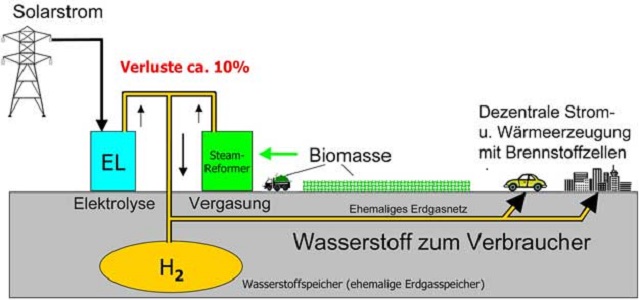Here I would like to list once the energies available to us
Hopefully soon PAST:
Nuclear energy: unacceptable for reasons of final storage and costs in the present form of production
Coal energy: Unacceptable due to CO2 pollution during combustion, gasification and efficiency
Natural gas energy: unacceptable due to CO2 pollution during combustion, gasification
Petroleum energy: unacceptable due to CO2 impact during combustion, gasification
Links to CO2: WMO Greenhouse Gas Bulletin (GHG Bulletin) - No. 17: The state of greenhouse gases in the atmosphere based on global observations up to 2020
Climate: CO2 needs ten years Greenhouse effect takes effect after a decade - but then remains for at least a century
In today's electricity industry, these forms of energy are converted into electricity. The energy produced during combustion is only partially utilized and the plants must be operated at a minimum output. The energy surplus heat, electricity can often not be consumed and is thus virtually destroyed. Electricity can directly NOT be stored.
Relating to renewable energies such as wind, PV are TODAY often shut down!
FUTURE :
Renewable energies, which are there:
PV Photovoltaic electricity can be consumed, or fed into the grid, is not always available.
Fraunhofer Current facts about photovoltaics in Germany 1MW ca.: 700.000 € 50 MW ca.: 35 Mill €
Wind power plants Electricity is fed into the power grid, is not always available.
Excerpt: Production costs of wind power plants 1 MW ca.: 890000€ per MW at 50MW ca.: 44,5 Mill €
Hydroelectric power plants electricity is fed into the grid 8.718 €/kW excerpt:
What are the acquisition and operating costs of hydropower plants?
232 data sheets with cost data were evaluated for the Hydropower Experience Report. For plants between 100 kW and 100 MW, total costs for new construction are assumed to be about 8,718 €/kW. It is assumed that an already high ecological standard is maintained for new construction. 1MW approx.: 8,718 Mill € 50MW approx.: 435,9 Mill €
Pumped storage power plants Water The overall efficiency of a pumped storage power plant is 75-80%, in exceptional cases somewhat higher. Actual surpluses of green electricity should be used for this purpose!
Costs pumped storage power plant Blautal example approx.: The PSW Blautal is with costs of 1.2 million €/MW or 0.2 million €/MWh in the upper range of existing and planned pumped storage power plants. 50 MW approx.: 60 million €
Tidal power plants Electricity is fed into the power grid Price very expensive New tidal power plants Would this not also be interesting in the North Sea area? Examples Schottel tidal energy coming from the depths
Bio-gas plants Gas and electricity is fed into the grid, thermal energy into heat grids if available
H2 by electrolysis Efficiency approx.: 60% Production costs This publication.
reference number: WD 5 - 3000 - 029/20
Completion of the work: 03. April 2020
Department: WD 5: Economy and Transport, Food, Agriculture and
Consumer Protection
should be looked at!
Case film electrolysis efficiency approx: >94%.
Bio hydrogen from waste biomass H2 is produced 24 hours a day, feeding into the former natural gas grid. Cold gas efficiency of over 83
Cost: 50MW H2 production plant approx.: 30 million € series model, pre-series model 70 million € approx.:10 tons of organic dry matter per hour needed
Cost: 500MW H2 generation plant approx.: 120 million € series model
At port locations also 5 GW model possible approx. 500 million €.
For biohydrogen from cascaded conversion, it is assumed that about 5% of the carbon in the biomass is not converted but is discharged with the ash and returned to the field. This 5% is about 25 kg of carbon per ton of biomass ( 50 MW power plant 10 tons of biomass per hour) absolutely dry. With 110 kg H2 production per ton of dry biomass, this is approx. 223 g carbon per kg hydrogen, i.e. a good 800 g CO2 that are permanently fixed. If CO2 is also injected into salt aquifers, the total amount of carbon saved per kg of hydrogen is 4.5 kg, or 110 g of carbon or 423 g of CO2 per kWh. With the current electricity mix of approx. 500 g CO2 per kWh, 42.5 g per kWh would have to be deducted for the required electricity, i.e. a negative footprint of 380.5 g per kWh or a CO2 footprint of 22.5 g/kWh for coke only. Electrolysis hydrogen would have a CO2 footprint of 714 g/kWh, but is valued at 0 g or at most 10 g wind or 5.7 g hydropower, hydrogen from natural gas comes to 210 g to 260 g.
It turns out that biohydrogen from cascaded conversion with 900 g CO2 per kg hydrogendefinitely gives a much better CO2 reduction!
Hydrogen from biomass on the rise
Green hydrogen can be produced from water using renewable electricity. But it can also be produced from biomass, such as plant residues and waste streams. These are abundant in industry, agriculture or private households. Today, they are mostly burned or composted, releasing CO2 emissions. However, the recovery of energy in the form of hydrogen from this residual biomass will become increasingly important in the future. And it has a clear advantage that can be decisive in the fight against climate change: Not only can CO2 be saved in the production of biohydrogen, but CO2 can even be extracted from the atmosphere: Climate change backwards!
Information: Hydrogen from biomass - climate positive beats climate neutral: Biointelligent hydrogen with a negative CO2 footprint
Where does wind power make sense?
Wind and solar power are cheap, climate friendly and should become the main pillars of energy supply in the future. But the energy yield varies greatly depending on the region. Which mix is best?
Again, H2 from waste biomass missing 1kWh 3 € cents.
The efficiencies of the individual production methods are still missing - these will be added. 26.12.2021
Green water economy Solar power Hydrogen economy
Translated with www.DeepL.com/Translator (free version)

